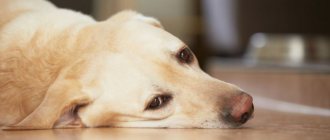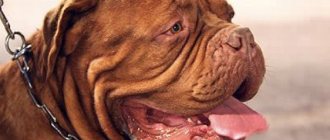Our smaller brothers are living beings. They, like people, tend to get sick sometimes. A common disease that causes dogs great discomfort, inconvenience and pain is sprained tendons and ligaments.
Ligaments in dogs are called organs that serve to connect joints to each other. This part of the body has a fibrous structure, and it happens that for a number of reasons the fibers can become damaged. This nuisance is called sprain.
The pet's condition and treatment algorithm depend on the severity of the injury. With a small rupture and damage to the ligamentous fibers, the dog quickly returns to normal. The lameness that appears gradually goes away, and mobility is quickly restored.
With extensive rupture of fibers (severe sprain), the animal’s condition can reach critical. Severe pain, accompanied by swelling of the limb and even bleeding, brings terrible suffering to the pet.
Causes of sprains
This is one of the most common injuries that this animal can receive in childhood by overloading its paw. The joint of the limb is designed to protect the bone from various types of damage, covering it with elastic fibrous tissue, and is also responsible for the process of shock absorption when walking or jumping. Stretching causes several of these fibers to break due to sudden overstrain. For an animal, this condition is very painful and unpleasant. It is expressed, among other things, by severe swelling of the paw.
Among the main reasons why a dog develops sprains, veterinarians identify the following:
- Limb injury. The most severe cases may even be accompanied by fractures or dislocations. In such cases, spraining is not the most significant problem.
- Incorrect nutrition. First of all, this concerns a lack of calcium, as well as some other microelements. As a result, elastic tissue loses its functions, which is accompanied by weakness of the ligaments.
- Genetic predisposition. Often, heredity in decorative dogs leads to the fact that they suffer from certain diseases, including abnormalities in the development of the ligamentous apparatus.
- Sudden weight gain. As a result, the animal’s body simply does not have time to fully adapt to the changes that have occurred to its body.
- Excess weight. In this case, the dog, despite its low mobility, can still get a sprain.
- Some types of loads during the active growth phase. First of all, this all concerns climbing to heights or overcoming large obstacles.
Sprained ligaments are a rather unpleasant consequence that can be influenced by all of the above factors. It requires a certain level of care for the pet and changes in its lifestyle. In any case, it is worth giving up regular workouts for a while.
Therapeutic treatment of ligament rupture in dogs
Treatment involves a number of therapeutic and health measures: anti-inflammatory therapy, restriction of the pet’s mobility and the use of special dog knee pads.
Anti-inflammatory therapy
If a cruciate ligament rupture is diagnosed, anti-inflammatory drugs are prescribed to relieve inflammation and reduce pain in the knee joint. The course of treatment and dosage are determined taking into account the weight of the animal and the course of the disease. For example, young dogs weighing up to 5 kg are prescribed Loxicom in suspension for up to 10 days (the dosage depends on the specific weight). For large pets, take Rimadyl or Previcox in tablet form.
It is not recommended to offer non-steroidal anti-inflammatory drugs to an animal without the advice of a veterinarian. Their incorrect use leads in most cases to severe irritation of the mucous membrane of the intestines and stomach, and in case of overdose and frequent use - to ulcers and erosions. Use medications only as prescribed by your veterinarian.
Limiting your pet's movements for up to 1 month
If the knee ligament is torn, it will be necessary to take strict measures to limit the movement of the pet. In case of a partial break, walking on a short leash for short distances is allowed. If the ligament is completely torn, the sick pet is kept in a small enclosure to avoid increased activity. The dog is strictly forbidden to make sudden movements, jumps, and even more so, forget about active games for a while.
Using knee pads for pets
This measure is effective only in complex therapy. Properly fixed therapeutic knee pads allow you to provide additional support to the joint during active activities and movements of your pet. It is important to remember that improper fixation can lead to deformation of the knee joint and the development of pathological conditions. Therefore, it is so important to entrust this procedure to professional veterinarians.
Symptoms of injury
The symptoms of sprains are quite characteristic and easily recognizable. This is due to the fact that after an injury and rupture, an inflammatory process begins in the limb. Depending on its severity, veterinarians distinguish three stages:
- Easy. The dog feels only slight pain, since several fibers have been torn, and the rest are intact.
- Average. In this case, the gap is more significant and serious. It still preserves the overall integrity of the paw joint.
- Heavy. This case is considered the most unfavorable. It characterizes a complete rupture of the ligaments. Often this pathology occurs against the background of fractures and dislocations. That is why veterinarians classify it as a separate type of limb injury.
If we talk about signs and symptoms, then it is definitely worth highlighting the following complex:
- Lameness. The animal tries very carefully to stand on the damaged paw.
- Swelling of the paw tissue. Swelling can be seen at the site where the damage occurred.
- Painful sensations. The dog pulls out its paw when examined.
- A certain position of the limb. Most often, the animal will hold it in a half-bent, suspended position. This is due to the fact that the dog will be afraid of the pain that he can get from leaning on his paw. In some cases, if the gap is significant, you can even determine by touch where it occurred.
- Increased body temperature. This only applies to the site of the inflammatory process.
- Skin damage. This happens when you get injured.
- Hematoma formation. This rarely happens when blood vessels are affected. If your dog has one or more of the above symptoms, you should contact your veterinarian.
Signs of torn ligaments in dogs
In the event of a violation of the integrity of the ligaments, the clinical picture of the disease may vary depending on the type of rupture and the degree of inflammation in the joint. Symptoms of the disease also depend on how damaged the menisci in the knee joint are.
An injured dog with a cruciate ligament rupture experiences severe pain in the knee joint with any movement. In the case of a partial rupture, the animal does not feel severe pain and only limps slightly on the injured limb. Due to the absence of a small number of signs, pet owners confuse a partial tear with a sprain and do not contact a veterinary clinic. But over time, the seemingly smallest gap often leads to disastrous consequences.
If we are talking about a complete rupture of the ligaments, the pet limps heavily or is constantly in a lying position with the paw bent under the body. There may also be a lot of whining from severe pain. A complete rupture of the anterior cruciate ligament in dogs is characterized by acute pain, swelling in the knee joint, and a gradual increase in body temperature. A high temperature may indicate a progressive infection in the affected joint.
Treatment of pathology
Treatment for sprains in dogs can be of two types: first aid and comprehensive primary therapy. If the pathology is mild or moderate, then the dog can remain at home. The most serious injury requires appropriate surgical intervention by doctors. In most cases, the hind legs are affected. This is due to the fact that they bear the largest share of loads, both when running and when jumping.
As first aid, it is worth determining the following sequence of actions:
- It is necessary to apply an ice pack to the place where the ligament was torn. This can help reduce swelling and the inflammatory process itself. In this way, new complications such as high fever or the development of hematoma can be prevented.
- After 15-20 minutes, you can remove the ice from the paw. A fairly tight bandage should be applied to it, thereby fixing the limb. This is necessary so that the dog cannot accidentally aggravate the existing damage.
- If your dog continues to experience severe pain and cannot find a place to rest, you should definitely see a veterinarian. This may indicate that the injury is serious and requires specialist intervention.
- Under no circumstances should you give your pet painkillers. This can significantly worsen the situation. When the dog stops feeling discomfort, it begins to lean on the sore leg, thereby continuing to tear the weak elastic fibers.
Treatment requires quite a long time, so every owner of his pet should understand how to carry out therapy in the following days after the animal’s condition has been relatively stabilized.
On the second day after a sprain, you should apply alcohol compresses to your leg. They help improve blood circulation and warming.
On the third day after the sprain, you can begin to lightly massage the paw. Thermal wraps and paraffin applications will also be useful.
On the fourth day after the injury, you can start using ointments and gels based on troxevasin. This greatly promotes healing. First of all, it is worth highlighting such drugs as Phytoelita and Hydrocortisone.
Attention! In the first few days after a sprain has occurred, it is worth very carefully monitoring the animal’s health. It is necessary to pay attention to the temperature of his body, as well as directly to the site of injury. If an abscess appears, this may indicate that the wound has become infected. Subsequently, the dog will have to be treated for this infection.
In most cases, a pathology such as sprained ligaments in dogs goes away within 3-5 days, if there are no additional problems or complications. When they are present, therapy can take a longer period.
Diagnosis of ligament rupture in dogs
A ligament rupture is diagnosed in a clinical setting by a qualified veterinarian. At the first appointment, an anamnesis is taken to determine the clinical picture and an examination of the injured pet is performed. To make an accurate diagnosis, the following diagnostic measures are used:
- Calf compression test. The dog is wearing a muzzle. The pet is placed on the couch on its side so that the injured limb is in an extended state. The knee joint is fixed in the desired position and the hock joint is carefully flexed/extended. If the shin moves forward, this indicates a complete rupture of the ligament. Anesthesia is administered before the procedure to relax the muscles.
- Cranial tension test. The dog is laid on its side so that the injured paw is on top. The femur and tibia are fixed with the help of hands, and then the tibia is slowly shifted in the cranial direction. Cranial displacement of the tibia relative to the femoral condyles indicates a severe ACL tear. The test is most often performed using sedatives.
- X-ray examination. In most cases, the two tests described above are sufficient to determine a ligament rupture. But in order to avoid consequences in the form of inflammatory processes and the development of pathological conditions, x-rays are prescribed. X-ray images can determine the presence of defects on the articular surface of the knee. As a rule, with a complete rupture of the ligaments, pathological changes on the surface of the sesamoid bones, patellas and joint cavities can be seen in the image.
- CT scan. If the ligament is severely torn, a CT scan is appropriate. A diagnostic study allows you to study certain changes in the bone structure of the knee joint and identify the presence/absence of osteophytes. Computed tomography, like x-rays, cannot be used as a basis for diagnosis. For an accurate picture, an arthroscopic examination is performed.
- Arthroscopy of the knee area. Partial anterior cruciate ligament rupture in large dogs is determined by arthroscopic examination. Diagnostics consists of introducing a device equipped with a microvideo camera into the joint cavity. This method allows you to most effectively and quickly determine the pathological condition of the meniscus and other structures of the knee joint.
All of the methods described above allow you to make an accurate diagnosis and prescribe appropriate treatment.
Surgical treatment of ligament rupture in dogs
The most effective treatment for a torn cruciate ligament in a dog is surgery. Today there are a large number of ways. But not all of them are effective. In our country, the modern treatment methods described below are actively used to maintain a high level of mobility of pets for many years.
Intracapsular method
The use of intracapsular technique allows you to restore the functionality of the knee joint. The essence of the method is to replace the anterior cruciate ligament with a reliable graft. The rehabilitation period lasts differently for all dogs, from 1 month or more. Over time, the graft takes root in the knee joint and represents a healthy ligament.
Extracapsular method
If a dog is diagnosed with a cranial ligament tear on the hind leg, an extracapsular treatment method may be used. Its use allows the knee joint to be stabilized using soft tissue or lateral sutures. The effectiveness of the method has been proven for dogs weighing from 12 to 15 kg. The animal calmly steps on the damaged paw 14 days after the operation.
Muscle transposition is suitable for all dogs without exception. The pet can freely stand on the affected limb 6 weeks after surgery. Lameness with proper rehabilitation and proper care disappears after 5 months.
Osteotomy
The use of this treatment method allows you to correct the anatomical structure of the knee joint and completely restore the functionality of damaged paws. Surgery is indicated for all types of dogs, from toy breeds to the largest pets. The advantage of the method is its high speed and rapid rehabilitation. After the operation, the limb is not fixed with a bandage. The recovery period lasts no more than 1 week.
If your dog is injured, do not delay visiting a veterinarian. Assess the situation soberly, provide first aid if possible, but under no circumstances attempt treatment yourself. Only a veterinarian can make an accurate diagnosis and prescribe the correct treatment! Remember, the future health of your pet depends only on you!
Why does sprain of the ligament system occur?
As for the main causes of dislocations, sprains and ruptures of ligaments, they are for the most part the following:
- injury to one of the paws. Such conditions can be accompanied not only by sprains, but also by fractures of the limb;
- unbalanced dog diet. This deficiency of nutrients can cause not only general weakness of the body, but also weakening of the ligamentous system of the limbs;
- genetic predisposition or any pathology. This problem is especially relevant for those breeds that are distinguished by fairly miniature size indicators;
- very sharp weight gain. This problem is typical for those breeds that are distinguished by their large dimensions. As a rule, the pet begins to grow very actively, and the ligamentous system does not have time to get used to such very drastic changes;
- obesity;
- excessive physical stress on the pet’s knee joints. This can happen when the dog begins to play sports very actively, so an unprepared animal can easily either stretch the ligament or tear it.
The duration of the illness may take a certain period of time. Therefore, the most important thing is love and care. The dog senses the mood of its owner and if it feels his support, the recovery process will occur much faster.
- Fresh – less than 3 days passed from the moment of injury to discovery.
- Stale – the dislocation is detected after 3–14 days.
- Old – the period of injury is more than 14–21 days.
- Open - accompanied by rupture of muscles and skin, without fracture.
- Closed – the skin and external tissues are not damaged.
Ignoring treatment is fraught with negative consequences for several reasons:
- An injured dog experiences pain, which may be accompanied by disobedience or aggression.
- The joint will recover in any case, however, an unfixed limb may heal incorrectly, which will disrupt the pace of life of the animal.
- In parallel with the dislocation, if left untreated, swelling and inflammation occur, which can subsequently lead to gangrene and loss of the limb.
- A severe dislocation is accompanied by rupture of the ligaments, the animal ceases to use the limb, and the muscles atrophy—in fact, paralysis.











